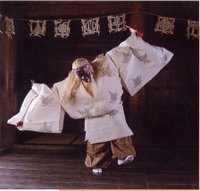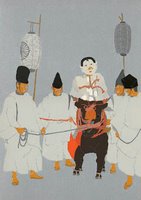:::::::::::::::::::::::::::::::::::::::::::::::::::::::::::::::::::::::::::::::::::::::::::::::::::::
Matarajin, Madarajin, Matara-Shin
摩多羅神
Mathara, Mahakala (Mahaakaala) まだらじん またらじん またらしん
Various spellings in English and Japanese are known.
For temple Motsu-Ji, see below.
This is a deity that was introduced to Japan from China by Ennin , Jikaku Daishi Ennin 慈覚大師仁円 as a protector deity of the Amida Sutra (Amida kyoo 阿弥陀経). Some say he is also the secretary of Emma, the main deity of the Buddhist Hell.
He seems identical to the deities Shinra Myoojin 新羅明神 and Sekizan Myoojin 赤山明神. Since the Heian Period, this deity has been vernated at temples of the Tendai sect of Esoteric Buddhism.
He was the main deity at some secret rituals of the Tendai sect (genshi kimyoodan 玄旨帰命壇) in the hall Joogyoodoo (Jogyodo) 常行堂(じょうぎょうどう)at Mt. Hiei (Hieizan 比叡山) and many statues had been made.
During the Genroku Period (1688-1704) these rituals were abolished at Mt. Hiei and most of the statues have been destroyed.
In the version of Shinra Myoojin he is the tutelary deity of the temple Miidera 三井寺.
Also called Shiragi Myoojin 新羅明神.
Shinra, the Japanese version of Silla, the Korean Kingdom.
The Hata clan (秦氏) was an immigrant clan active in Japan since the Kofun period, according to the epic history Nihonshoki.
Hata is the Japanese reading of the Chinese (state and dynasty) name 秦 given to the Qin Dynasty (the real family name was Ying), and given to their descendants established in Japan. The Nihonshoki presents the Hata as a clan or house, and not as a tribe; also only the members of the head family had the right to use the name of Hata.
... Some scholars say Hata clan 秦氏 did not come from Baekje, but Silla or Gaya area.
http://en.wikipedia.org/wiki/Hata_clan

Shinra Shrine (新羅神社 Shinra Jinja) in Fukui prefecture is believed to enshrine the tutelary deity of immigrants from ancient Korean Shinra (or Shiragi, 新羅) around the 4-7 century.
Immigrants from ancient Korean were employed as technical specialists of sericulture, fabric, papermaking, ironmaking and blacksmith, which are traditional handicrafts descended from generation to generation in the Hokuriku district.
- Shared by Taisaku Nogi -
Joys of Japan, 2012
. Kara no kami 韓神 / 漢神 Deity from Korea .
and the Sonokara Futakami no Matsuri Festsival
Read Mark Schumacher about
Shinra Myoujin 新羅明神 at Mt. Hiei
:::::::::::::::::::::::::::::::::::::::::::::::::::::::::::::::::::::::::::::::::::::::::::::::::::::
Bernard Faure about this deity:
My hypothesis is that Daruma came to be perceived, in circumstances that remain obscure, as such a placenta deity — a god which was often described as “the warp and woof of heaven and earth.”
The demiurgic of this deity explains its identification with the stellar god of the “fundamental destiny” (honmyoo), that is, the Polar Star. This is for instance the case with Matarajin, which, as Suzuki Masataka has shown, was one of the main aspects of a “god of destiny” [shukushin], both astral and embryological deity, governing life on both macrocosmic and microcosmic, astral and uterine planes.
Read: Daruma, Smallpox and the color Red,
the Double Life of a Patriarch
:::::::::::::::::::::::::::::::::::::::::::::::::::::::::::::::::::::::::::::::::::::::::::::::::::::
kigo for the New Year
Festival in Honor of Matarajin
Mootsuji Matarajin sai (Motsuji Temple, Hiraizumi, Iwate)
January 20
平泉毛越寺(もうつうじ)延年の舞Motsu-Ji Ennen no Mai
hatsuka yomatsuri 二十日夜祭(はつかよまつり)
night festival on January 20
Ennen no Mai is performed at Motsuji Temple (close to Chusonji) in Hiraizumi in the south of Iwate prefecture. It is performed on 20 January, following a Buddhist memorial service dedicated to Matarashin (Tamarashin).
The dance is in praise of the mountain guardian god and it recreates the graceful atmosphere of time honoured rituals of the Heian Period (794-1192). The dance includes several variations:

Dengaku (Buddhist ritual music), Rojo (old woman), Hanaori and Chokushi Mai (dances by an imperial mission), Karashi (Chinese lion) and Norito (prayer). The most solemn and mystic is Rojo. A dancer wearing the white hair and mask of an old woman and dressed in‘hakama’split skirts with a two-tone cord, dances holding a folding fan and a bell. In the dancer’s soundless slow movements there is a unique rhythm which makes the audience forget the passing of time.
http://www.pref.iwate.jp/english/traditionals/traditionals.html
. Legend of the White Deer of Motsu-Ji .

Motsuji was founded by Ennin (Jikaku Daishi; see the legend of the White Deer), though most of its structures were not built until the twelfth century, when the second and third Hiraizumi Fujiwara lords, Motohira and Hidehira, brought the temple to prominence.
- Motsu-Ji Homepage - Osawa, Hiraizumi, Iwate 029-4102
- source : motsuji.or.jp/english -

毛越寺 Joogyoo Hall 常行堂 Jogyo-Do at Mootsuji
http://www.st.rim.or.jp/~success/ennin_ye.html
. Hiraizumi Fujiwara Festival
平泉藤原祭 (ひらいずみふじわらまつり)
kigo for late spring
with Noh-Performance and more
:::::::::::::::::::::::::::::::::::::::::::::::::::::::::::::::::::::::::::::::::::::::::::::::::::::
Rain Ritual at Amabiki Kannon
(Rain Pulling Goddess of Mercy) Temple Rakuhooji (Rakuhouji), Ibaraki
The deity celebrated at this festival is Madara Kishin.
Madara Kishin Sai マダラ鬼神祭 Madara Festival
First Sunday in April
observance kigo for mid-spring
The ritual had been abolished, but is now performed again and soon became one of the two big "oni" Demon Festivals of Japan 日本二大鬼祭.
When the ship of the temple founder was in distress in the China Sea he prayed and Madara came to appease the waters. When he came to this temple, which had been burned down, he could rebuild it with the help of the deity within seven days and nights.
ONI 鬼 at that time could be any outsider or foreigner in Japan.
摩多羅鬼神祭


Look at more photos:
source : noasobi
A red and green demon greet the Madara Oni, who comes on a horse with children as his attendants. A goma fire is burned for purification of the four regions.
Madara is the protector deity of the Fudaraku Paradise.
『補陀洛浄土』の守護神. 雨引観音 雨引山 楽法寺
文明4年(1472)春3月、当山炎上の際(一説に応永3年とも云われている)摩多羅神現れ玉いて、鬼類を督して七日七夜にして荘厳な現在の観音堂を建立したといわれている。摩多羅鬼神祭は、この鬼神の恩徳に報謝せんがために、寛永18年(1641)当寺住職尊海が時の老中松平伊豆守信綱の庶弟であった縁を以て、幕府に願い出て許され、同年3月より、当山の年中行事の大祭として修行し来ったものであり、実に350年の伝統を有する北関東随一の大祭である。
因みに当山の摩多羅鬼神祭は、京都太秦の広隆寺の摩多羅祭と共に、日本二大鬼祭の一といわれ、一方の広隆寺が、牛を使うのに対し、当山のマダラ神は、馬にまたがる訳で、東西まさに正反対であることは、奇縁といわねばならない。
猶、寛永の昔、この祭典を始めるに当たり、時の老中松平伊豆守信綱侯が当山に寄進された袈裟は今日に伝えて、摩多羅鬼神祭の当日、マダラ神が被着している。
http://www.amabiki.or.jp/42.htm
Reference:
Rain Rituals (amagoi)in Japan and worldwide
. OBSERVANCES – SPRING SAIJIKI .
:::::::::::::::::::::::::::::::::::::::::::::::::::::::::::::::::::::::::::::::::::::::::::::::::::::
Japanese Links
広隆寺の牛祭りは
円仁によって始められたと述べ、『 魔多羅神は、比叡山では現世利益の神として崇められてきたが、叡山の麓の赤山禅院 で赤山明神即ち泰山府君 として祀られてきた。人の生死を司る神であるとも、閻魔大王の書記ともいう。
Very detailed essay:
黒沢一功の話
円仁と多神教
摩多羅神とはいったいどんな神なのだろう。平泉名勝誌(明治37年刊)によれば、それは「五方鎮守の一にして中央の鎮守なり」と極めて簡単に説明されている。
「常行堂摩多羅神事」
「唐で引声念仏を学んだ慈覚大師が帰朝の途中、虚空に声がした。『私の名は摩多羅神といい、障(しょう)げ神である。私を奉斉しなければ浄土往生はかなわないだろう』。そこで円仁は常行堂にこの神を勧請したという。」
少しだけ、摩多羅神の正体が明らかになった。摩多羅神は、外国から来た厄(わざわい)をもたらす怖い神様なのである。この神様を祭らなければ、往生できないというのであれば、阿弥陀如来は、往生の時に現れる仏であるから、摩多羅神は、さしずめ阿弥陀の裏の姿ということもできる。仏になればアミダとなり神になればマタラジンとなるこの神仏の二重性が、この常行堂の秘密であり、円仁が日本の宗教の中に取り入れた一種の魔法のようにも思える。
Very interesting essay:
http://www.st.rim.or.jp/~success/ennin_ye.html
:::::::::::::::::::::::::::::::::::::::::::::::::::::::::::::::::::::::::::::::::::::::::::::::::::::
Matarajin as a kigo for haiku
Bull Festival, ushi matsuri 牛祭
Bull Festival of Uzumasa, 太秦の牛祭
God Matara, matara jin 摩多羅神
This is a Buddist festival for the Deity Matarajin. The God appears riding on the black cow. The festival is held in Kyoto on the 12th of October at the temple Kooryuu-Ji (Koryuji 広隆寺).

Copyright TANAKA MASAAKI All right reserved.
Look at more prints of festivals by Tanaka san.
http://www.masaakitanaka.co.jp/english/kyoto.htm

source : tois.nichibun.ac.jp
太秦牛祭 Uzumasa Ushi Matsuri
quote
The Hata clan (秦氏)
was an immigrant clan active in Japan since the Kofun period, according to the epic history Nihonshoki.
The first leader of the Hata to arrive in Japan, Uzumasa-no-Kimi-Sukune, arrived during the reign of Emperor Chūai, in the 2nd century CE. According to the epic, he and his followers were greeted warmly, and Uzumasa was granted a high government position.
© More in the WIKIPEDIA !
. The Hata Clan 秦氏 Hata Uji .
and the Korean and Christian connection
:::::::::::::::::::::::::::::::::::::::::::::::::::::::::::::::::::::::::::::::::::::::::::::::::::::
[ . BACK to WORLDKIGO TOP . ]
[ . BACK to DARUMA MUSEUM TOP . ]
:::::::::::::::::::::::::::::::::::::::::::::::::::::::::::::::::::::::::::::::::::::::::::::::::::::








2 comments:
。
More about
Temple Miidera 三井寺
Zen-In, Sekizan Zen-In 赤山禅院
and
Shinra Myōjin
.
http://gokurakuparadies.blogspot.jp/2014/06/zen-in-kyoto.html
Post a Comment